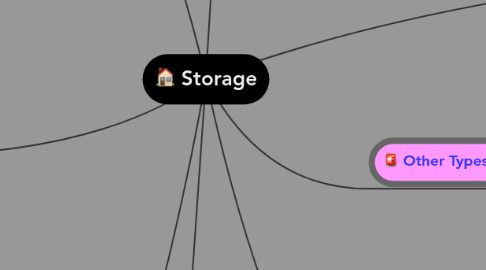
1. Capacity
1.1. is the number of bytes a storage medium can hold
1.1.1. 1 TB (Terabyte) = 1,000,000,000,000 Byte
1.1.2. 1 GB (Gigabyte) = 1,000,000,000 Byte
1.1.3. 1MB (Megabyte) = 1,000,000 Byte
1.1.4. 1 KB (Kilobyte) = 1,000 Byte
1.1.5. 1 Byte = 8 Bits
2. Flash Memory Storage
2.1. Flash memory chips are a type of solid state media and contain no moving parts Solid state drives (SSDs) have several advantages over magnetic hard disks: Faster access time , Faster transfer rates , Generate less heat and consume less power , Last longer
2.2. A memory card is a removable flash memory device that you insert and remove from a slot in a computer, mobile device, or card reader/writer
2.2.1. CompactFlash ( CF)
2.2.2. Secure Digital ( SD)
2.2.3. Secure Digital High Capacity (SDHC)
2.2.4. microSD
2.2.5. microSDHC
2.2.6. xD Picture Card
2.2.7. Memory Stick
2.2.8. Memory Stick Micro (M2)
2.3. USB flash drives plug into a USB port on a computer or mobile device
3. Cloud storage
3.1. Cloud storage is an Internet service that provides storage to computer users
3.2. Face Book , MySpace , Youtube , Gmail , Window Live Hotmail , Window Live SkyDrive
3.3. Users subscribe to cloud storage for a variety of reasons: Access files from any computer > Store large files instantaneously > Allow others to access their files > View time‐critical data and images immediately > Store offsite backups > Provide data center functions
4. Putting It All Together
4.1. Home user
4.1.1. 320 GB hard disk
4.1.2. Cloud storage
4.1.3. Optical disc drive
4.1.4. Card reader/writer
4.1.5. USB flash drive
4.2. Small Office/Home Office user
4.2.1. 1 TB hard disk
4.2.2. Cloud storage
4.2.3. Optical disc drive
4.2.4. External hard disk for backup
4.2.5. USB flash drive
4.3. Mobile
4.3.1. 250 GB hard disk
4.3.2. Cloud storage
4.3.3. Optical disc drive
4.3.4. Card reader/writer
4.3.5. Portable hard disk for backup
4.3.6. USB flash drive
4.4. Power User
4.4.1. 2.5 TB hard disk
4.4.2. Cloud storage
4.4.3. Optical disc drive
4.4.4. Portable hard disk for backup
4.4.5. USB flash drive
4.5. Enterprise User (desktop computer)
4.5.1. 1 TB hard disk
4.5.2. Optical disc drive
4.5.3. Smart card reader
4.5.4. Tape drive
4.5.5. USB flash drive
4.6. Enterprise User (server or mainframe)
4.6.1. Network storage server
4.6.2. 40 TB hard disk system
4.6.3. Optical disc server
4.6.4. Microfilm or microfiche
5. What is??
5.1. Storage holds data, instructions, and information for future use
5.2. A storage medium is the physical material on which a computer keeps data, instructions, and information
5.3. A storage device is the computer hardware that records and/or retrieves items to and from storage media
5.4. Hard Disk Drive , External HDD , USB , Memory Card , Disket , Compact Disc (CD) , Digital Video Disk (DVD) , Blu-ray Disk , Etc.
6. Hard Disk Drive (HDD)
6.1. A hard disk contains one or more inflexible, circular platters that use magnetic particles to store data, instructions, and information can store data using longitudinal recording or perpendicular recording
6.2. RAID (redundant array of independent disks) : is a group of two or more integrated hard disks A network attached storage (NAS) device is a server connected to a network with the sole purpose of providing storage
6.3. A disk controller consists of a special‐purpose chip and electronic circuits that control the transfer of data, instructions, and information from a disk to and from the system bus and other components of the computer SATA , EIDE , SCSI , SAS
7. Optical Discs
7.1. An optical disc consists of a flat, round, portable disc made of metal, plastic, and lacquer that is written and read by a laser
7.2. Typically store software, data, digital photos, movies, and music
7.3. Read only vs. rewritable
7.4. Optical discs commonly store items in a single track that spirals from the center of the disc to the edge
7.5. Track is divided into evenly sized sectors
7.6. A CD‐ROM can be read from but not written to Read from a CD‐ROM drive or CD‐ROM player
7.7. A CD‐R is a multisession optical disc on which users can write, but not erase
7.8. A CD‐RWis an erasable multisession disc Must have a CD‐RW drive
7.9. Archive disc
7.9.1. Stores photos from an online photo center
7.9.2. Resolution usually is 7200 pixels per photo
7.9.3. Cost is determined by the number of photos being stored
7.10. Picture CD
7.10.1. Single‐session CD‐ROM that stores digital versions of film
7.10.2. Typically uses a 1024 x 1536 resolution
7.10.3. Many photo centers offer Picture CD services
7.11. A DVD‐ROM is a high‐capacity optical disc on which users can read but not write or erase Requires a DVD‐ROM drive
7.12. DVD‐RW, DVD+RW, and DVD+RAM are , high‐capacity rewritable DVD formats
8. Other Types of Storage
8.1. Tape is a magnetically coated ribbon of plastic capable of storing large amounts of data and information
8.2. A tape drive reads and writes data and information on a tape
8.3. A magnetic stripe card contains a magnetic stripe that stores information
8.4. A smart card stores data on a thin microprocessor embedded in the card
8.5. Microfilm and microfiche store microscopic images of documents on a roll or sheet flim
8.6. Enterprise storage stores huge volumes of data and information for large businesses
8.6.1. Uses special hardware for heavy use, maximum availability, and maximum efficiency
